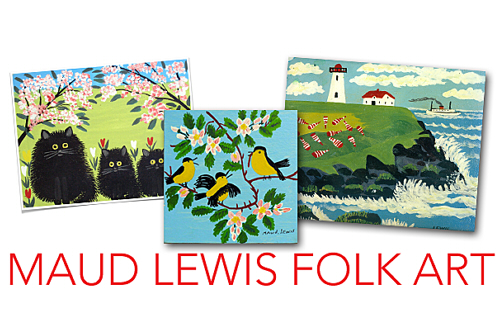Home Is Where the Art Is: The Unlikely Story of Folk Artist Maud Lewis
艺术为家:民间画家刘易斯的非凡故事
By Susan Stamberg & Alexxa Gotthardt
文/苏珊·斯坦伯格、亚利克斯萨·戈特哈特
There’s no rain in her clouds, no gray in her shadows; Maud Lewis’ small paintings are bright with sunshine, and filled with blue skies, crystal snow and calm waters.
所画非愁云,笔下无暗影。莫娣·刘易斯的小幅画作里总有着明媚的阳光、蔚蓝的天空、晶莹的白雪和平静的水面。
Lewis was born in 1903 in the small, seaside town of Yarmouth[1], Nova Scotia. She had no formal training, but got her start painting Christmas cards with her mother, which they sold for 25 cents. As an adult, she used leftover house paint to brighten walls, bread boxes, cookie sheets – even the stove – with butterflies, tulips and swans. Canvas[2] was expensive and hard to come by, so Lewis painted on beaver boards[3] and Masonite[4] – and she did it all from her own imagination.
1903年,刘易斯出生于新斯科舍省的海滨小镇雅茅斯。她并未受过正统的绘画训练,第一次接触绘画,还是和母亲一起绘制25加分一张的圣诞贺卡时。成年后的她,喜欢用家里剩余的涂料来装点房间,把墙面、面包盒子、烤盘,甚至灶台都画上蝴蝶、郁金香和天鹅。帆布价格高,也不易买到,刘易斯就在纤维板和复合板上作画——而怎么画则全凭想象。
[1] 加拿大新斯科舍省西南部海港。
[2] canvas 帆布,可用作画布。
[3] beaver board 一种纤维板,用作建筑材料。
[4] Masonite 美森耐复合板,用作建筑材料。
“I’ve never seen any paintings from other artists,” said Lewis.
“我从来没看过别的画家的作品。”刘易斯说。
Lewis had rheumatoid arthritis[5], which made it difficult for her to work, even as a young woman. To support herself, she took a job cooking and cleaning for a fish peddler – Everett Lewis, a man she would later marry.
刘易斯年纪轻轻就患有类风湿性关节炎,工作起来有诸多不便。为了生计,她找到一个工作,帮一个鱼贩做饭、打扫卫生。鱼贩名叫埃弗里特·刘易斯,也就是她后来的丈夫。
[5] rheumatoid arthritis 类风湿性关节炎。
After she moved into Everett’s home, she began painting on its wooden surfaces. She’d travel into town with Everett and sell unique handpainted Christmas cards, and then moved on to larger surfaces: boards cut by her husband. Her paintings show scenes she glimpsed through her little home’s window, and memories from childhood or her infrequent trips to town. There are oxen decorated with bells and flanked[6] by trees exploding with pink blossoms; carriages filled with brightly outfitted people, trailed by bounding dogs; seagulls soaring[7] over placid seaside landscapes. And then there are the fan favorites: wide-eyed cats lounging[8] in tulip fields.
搬到埃弗里特家之后,刘易斯开始在家里各种木质表面上作画。她也会和埃弗里特一起到镇上去,兜售她手绘的那些别具风格的圣诞卡。后来,她绘画的阵地逐渐由小卡片转移到了大一些的表面:由丈夫切割的木板。而画的内容,或是她从小小的家中瞥见的窗外景象,或是童年时候的回忆,或是偶尔去镇上时的一些所见。有公牛戴着铃铛,两旁树木开满了粉色的花;有马车载着衣着光鲜的人,后面的狗蹦蹦跳跳地跟着;有海鸥飞翔在宁静的海边。还有画迷们所钟爱的猫咪,瞪着圆鼓鼓的眼,慵懒地站在郁金香的花田里。
[6] flank 在……的侧面。
[7] soar 翱翔;高飞。
[8] lounge 懒洋洋地站(或坐、躺)着。

Claire Stenning, an art dealer and early supporter, describes her sense of Lewis’s compositions in the 1965 documentary[9]. They have a “childlike, tremendous[10] feeling,” she said. “No shadows at all. Everything is happy and gay and quick and lively.”
艺术商人克莱尔·斯代宁是刘易斯的早期支持者,在1965年的那部纪录片中她曾这样谈及对刘易斯作品的感受:她的画给人一种“天真烂漫的美妙感觉。没有一点儿阴郁。一切都充满了欢乐,轻快活泼。”
[9] 指1965年加拿大广播公司(Canadian Broadcasting Corporation,简称 CBC)《望远镜》(Telescope)栏目制作的纪录片The Once-Upon-a-Time World of Maud Lewis,讲述刘易斯的作品和生平。
[10] tremendous极好的。
The joyousness of Lewis’s paintings may be surprising given the difficulties she faced. As a child, she was made fun of for her arthritis, which worsened over the course of her life, gnarling[11] her body and hands.
考虑到刘易斯生活中面临的种种艰辛,她作品中洋溢的那种欢乐或许令人感到讶异。小时候,因为关节炎,她常遭人取笑,在后来的日子里,病痛日益加重,更使她体态佝偻、双手畸形。
[11] gnarl 使扭曲。

Lewis painted what she saw – cows, horses, cats, oxen – “often with a very cheeky[12] sense of humor,” says Shannon Parker, Curator of Collections at the Art Gallery of Nova Scotia[13], Halifax. The gallery has 55 of Lewis’ paintings in their permanent collection.
刘易斯笔触下的一事一物——牛啊,马啊,猫啊——“常带有一种肆无忌惮的幽默感”, 哈利法克斯市新斯科舍美术馆策展人香农·帕克如是说。迄今,该馆永久收藏着55幅刘易斯的画作。
[12] cheeky 鲁莽的;放肆的。
[13] 该美术馆位于加拿大新斯科舍省的哈利法克斯市。
Lewis became known in the late 1960s, as passing tourists saw her sign: “Paintings for Sale.” These were landscapes, painted on boards. She charged $2.00, later, $5.00.
1960年代末,刘易斯开始渐为人知,来来往往的游客看见了她写有“出售画作”的标示牌。都是一些画在木板上的风景画。一幅2加元,后来,5加元。
“She was very hesitant to ask for more money,” Parker says.
“她不愿意多要价。”帕克说道。
A writer learned about her, there was a magazine article, then the CBC interviewed her, and eventually she couldn’t keep up with the demand. She began selling her pictures while they were still wet. Now her paintings sell for $8,500 to $20,000.
有位作家听了她的故事,写了篇文章登在杂志上,后来加拿大广播公司采访了她,再后来,她的画供不应求了,有时还没晾干就被人收入囊中。如今,她的画作一幅售价8500到20000加元。
After Lewis and her husband died, their entire house – a work of art in and of itself – was moved from its original location in the 1980s as part of an effort by a group of concerned citizens to save this valued landmark. The final, fully restored house is on permanent display in the Art Gallery of Nova Scotia. In the years before she died, Lewis told the CBC she rarely left home. “Contented right here in this chair,” she said. “Ain’t much for travel anyway. As long as I’ve got a brush in front of me, I’m all right.”
刘易斯和丈夫居住的屋舍,本身就是一件为世人所珍视的艺术品。二人过世后,为保护这座颇具纪念意义的故居,1980年代,一些热心市民协助相关机构将其由原址迁出并作修缮。最终修缮完毕的房屋已永久展览于新斯科舍美术馆。晚年接受CBC采访时,刘易斯曾说,她鲜少出门。“有这把椅子就够了,”她说,“我也不太爱出远门。只要跟前有支画笔,就挺好。”
Parker thinks Maud’s popularity and her story is a work of slow magic. “They didn’t have a lot of money,” Parker says. “They had no running water, they had no electricity. [She] was very limited in what she was able to do with her life. And yet her artwork was what she wanted to do and it’s something she was able to do. And touched so many other people. That’s pretty amazing.”
在帕克看来,莫娣的名气与她的故事,就像是生活不急不躁地施了一个魔法。“他们没多少钱,”帕克说,“没有自来水用,也没有电。她的人生中能做的事情非常有限。但绘画是她想做的事,也是她能做的事。感动了那么多人,真是了不起。”
(译者单位:天津铁道职业技术学院)








